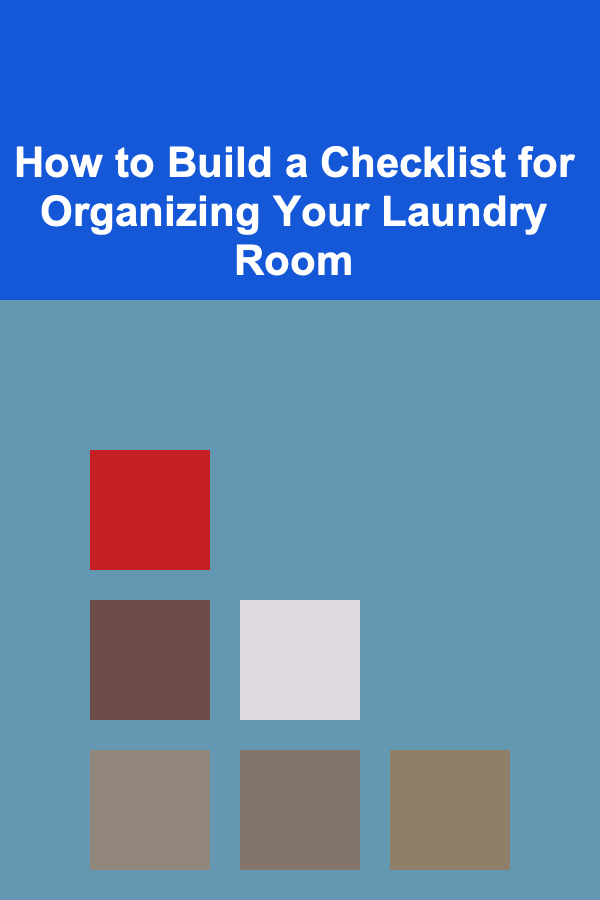
How to Build a Checklist for Organizing Your Laundry Room
ebook include PDF & Audio bundle (Micro Guide)
$12.99$10.99
Limited Time Offer! Order within the next:

A well-organized laundry room can transform an otherwise mundane household chore into a more efficient, pleasant experience. When your laundry room is organized, you'll find that you're able to keep track of supplies, streamline your workflow, and even reduce stress. Building a checklist for organizing your laundry room is a great way to ensure that you cover all the bases, from storage and cleaning supplies to efficient layout design.
In this guide, we will walk you through how to create a comprehensive laundry room organization checklist, providing actionable steps to optimize space, improve functionality, and keep things in order. Let's dive in!
Assess Your Space and Needs
Before diving into the organization process, it's important to assess your laundry room's size, layout, and what you actually need from the space. Not all laundry rooms are created equal; some are large with abundant storage options, while others may be small, utilitarian spaces that serve only basic functions.
Evaluate Available Space
- Measure the Room: Take the time to measure your laundry room's dimensions. This will help you determine what storage solutions are possible, whether it's shelves, cabinets, or a folding station.
- Existing Furniture and Fixtures: Make note of any large items already in the space, such as the washer, dryer, sink, or any cabinetry. Consider how these can be used or if they need to be replaced.
- Flow and Layout: Think about the flow of the room. Does the layout make sense? Is there enough space to move around, or do you need to rearrange things for better accessibility?
Define Your Needs
Ask yourself what functions you want the laundry room to serve beyond just washing clothes. For example:
- Do you need space for sorting clothes?
- Would a designated folding area be useful?
- Do you need to store cleaning products, detergents, or supplies for other household chores?
- Is there a need for a space to hang clothes?
Understanding how you use the space and what it must accommodate will inform the types of organization solutions you'll need.
Declutter and Purge Unused Items
A key component of organizing any space is decluttering. It's easy to accumulate items in your laundry room over time that no longer serve a purpose, or that just add unnecessary bulk to the space.
Start with a Purge
- Old Detergents or Cleaning Products: Expired or unused products can take up valuable space. Dispose of anything you don't use.
- Unnecessary Tools and Items: Check for tools, old hangers, or empty containers that no longer have a purpose. Keep only items that serve your current needs.
- Old Laundry Baskets and Hampers: If your baskets or hampers are worn out or no longer functional, it might be time to invest in new ones that suit your current organization system.
Decluttering will create a cleaner, more streamlined space, making it easier to visualize how you want to organize the room.
Plan Your Storage Solutions
Once the space is cleared and the area is assessed, it's time to plan out storage solutions that maximize efficiency and reduce clutter. Consider both vertical and horizontal storage to make the best use of the available space.
Shelving and Cabinets
- Wall-Mounted Shelves: For smaller items such as detergent bottles, fabric softener, and cleaning supplies, wall-mounted shelves can save counter space and keep things organized.
- Closed Cabinets: If you prefer a more streamlined look, installing cabinets to store your supplies can reduce visual clutter and protect your products from dust and spills.
- Overhead Storage: If the room allows, consider utilizing overhead storage for items you use less frequently. This could be for seasonal laundry products or spare towels and linens.
Hampers and Baskets
- Sorting Bins: If you tend to sort laundry by color, fabric, or type (e.g., whites, colors, delicates), use labeled hampers or bins to make sorting easy. Stackable bins can help save space and allow you to keep your laundry system organized.
- Portable Hampers: For convenience, consider collapsible or portable hampers that can be easily moved from room to room or even taken on laundry trips to the laundromat if necessary.
Counter Space
- Folding Table: If you have the room for it, a sturdy folding table or counter space is a must for folding clothes. Ensure the table is at a comfortable height for working.
- Drying Rack: For delicate items, include a foldable drying rack that can be stored when not in use. This is particularly useful if you don't have a clothes dryer or prefer air-drying certain clothes.
Pegs and Hooks
- Wall Hooks: Installing hooks on the wall can help you hang up items you don't want to put in the dryer, such as delicate garments, scarves, or even coats.
- Pegboard or Grid System: A pegboard or grid wall is a versatile storage option where you can hang cleaning tools, clothespins, or other items you frequently use.
Organize Laundry Supplies Efficiently
Now that you have a plan for storage solutions, it's time to organize your supplies in a way that ensures accessibility and minimizes clutter.
Categorize and Label
- Label Bins and Shelves: Label everything clearly. Whether you're organizing detergent, bleach, or dryer sheets, labels help you easily identify products, reducing time spent searching.
- Use Clear Containers: Opt for transparent containers for easy visibility of what's inside, especially when it comes to detergents, fabric softeners, and stain removers.
- Group Similar Items Together: Store like-items together for easy access, such as keeping fabric softener near the dryer or hanging laundry bags near the washer.
Keep Cleaning Products Accessible
- Daily Use Products: Keep your everyday laundry items---detergents, softeners, and stain removers---within easy reach.
- Seasonal or Bulk Products: For items you don't need every day, such as seasonal detergents or large bottles of detergent, store them higher up or in a separate closet or storage area.
Ensure a Functional and Efficient Workflow
An organized laundry room should facilitate a smooth workflow, minimizing the time and effort needed to do your laundry. Think of the process as a flow---from sorting clothes to washing, drying, folding, and ironing. Each task should have a designated area, and your storage solutions should allow for seamless transitions between each step.
Create Stations for Each Task
- Sorting Station: Designate a specific area for sorting laundry, whether it's a row of bins or a designated shelf. This should be the first step in the process to help you separate clothes by color, fabric type, or washing instructions.
- Washing and Drying Area: Your washer and dryer should be positioned for maximum efficiency. Make sure there's enough space around the appliances to load and unload easily.
- Folding and Ironing Area: Ensure there's enough flat surface for folding clothes and possibly a space for ironing or steaming.
- Drying Area: If you're air-drying clothes, make sure your drying rack or clothesline is easily accessible but doesn't get in the way of other tasks.
Consider Workflow Efficiency
Ensure that the movement between these stations is logical and seamless. You don't want to be walking across the room multiple times to move clothes from one area to the next. If possible, position items in a way that follows the natural flow of laundry: sorting, washing, drying, folding.
Maintenance and Ongoing Organization
Once your laundry room is organized, it's important to maintain the system you've created. A laundry room can quickly become cluttered again if you don't regularly assess the state of your supplies and systems.
Regularly Purge Unnecessary Items
Take the time to revisit your laundry room every few months to get rid of empty bottles, expired products, or items that no longer serve your needs.
Stay Consistent with Organization
Try to keep things in the same place consistently. This will make it easier to grab what you need without hunting for it. Regularly putting items back where they belong will save time and prevent clutter from building up.
Reassess Your Needs
As your family's laundry habits change, reassess the storage needs and layout of your laundry room. Adding new appliances or incorporating a new family member's laundry requirements might require you to tweak your systems.
Conclusion
Building a checklist for organizing your laundry room requires thoughtful planning and consideration of your space, needs, and workflow. By assessing the room, purging unnecessary items, planning efficient storage solutions, and ensuring an easy-to-follow workflow, you'll create a space that simplifies your laundry tasks and reduces clutter.
With an organized laundry room, doing laundry becomes more than just a chore---it becomes a seamless, stress-free part of your routine. Happy organizing!
Reading More From Our Other Websites
- [Organization Tip 101] How to Create a Digital Catalog of Vintage Items
- [Home Maintenance 101] How to Minimize Maintenance Costs of Your House Over Time
- [Home Renovating 101] How to Plan for Outdoor Living Spaces in Renovation
- [Home Staging 101] How to Create a Cozy Feel with Staging: What Techniques Make a Home Feel Warm and Welcoming?
- [Skydiving Tip 101] Beyond the Freefall: Unforgettable Skydiving Locations Around the World
- [Organization Tip 101] How to Manage Passwords Safely with a Password Manager
- [Personal Care Tips 101] How to Match Your Perfume with Your Fashion Style
- [Home Rental Property 101] How to Handle Security Deposits Correctly: A State-Specific Guide for the USA
- [Survival Kit 101] Best Survival Kit for Boaters and Kayakers Navigating Unpredictable Rivers
- [Organization Tip 101] How to Store Baking Supplies Neatly for Easy Access

How to Optimize Closet Space with Creative Solutions
Read More
How to Transform Your Walls with Budget-Friendly Art
Read More
The Customer Support Specialist's Toolkit: Proven Techniques for Managing Inquiries and Delivering Exceptional Service
Read More
How to Use Virtual Reality in Marketing
Read More
How to Create Engaging Science Experiments for Kids
Read More
Selecting the Best Bearing Press Set for Bottom Brackets and Hubs
Read MoreOther Products

How to Optimize Closet Space with Creative Solutions
Read More
How to Transform Your Walls with Budget-Friendly Art
Read More
The Customer Support Specialist's Toolkit: Proven Techniques for Managing Inquiries and Delivering Exceptional Service
Read More
How to Use Virtual Reality in Marketing
Read More
How to Create Engaging Science Experiments for Kids
Read More